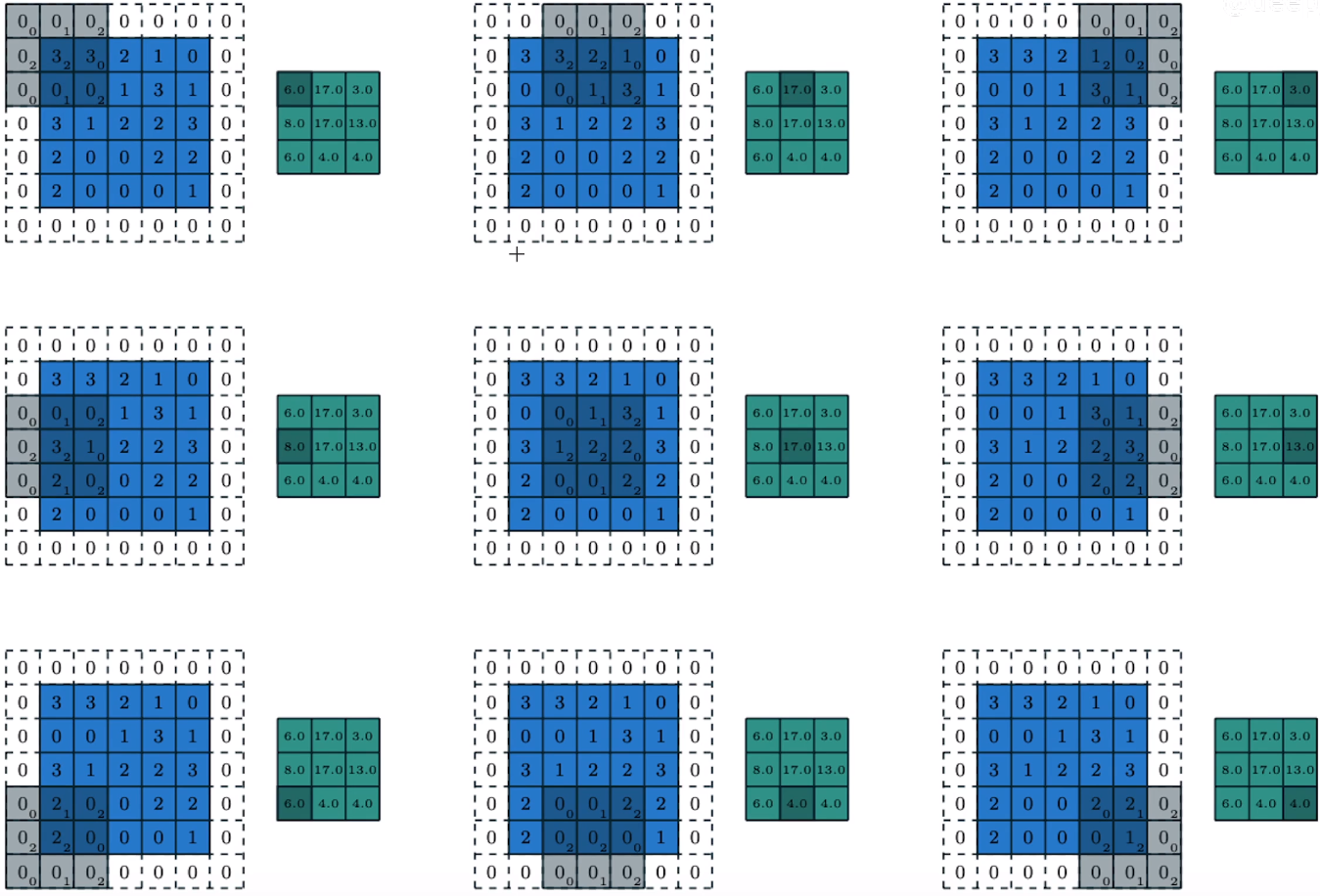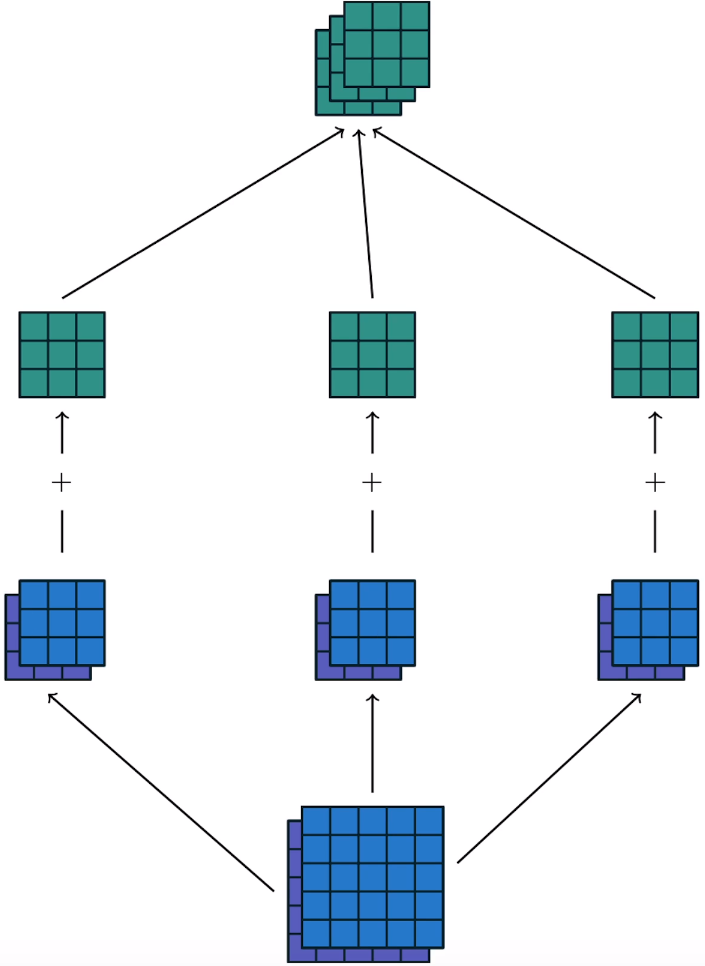蓝色的input_feature 5*5
深蓝色小字部分kernel_size 3*3
绿色部分out_feature 3*3
stride = 1
padding = 0
channel = 1

padding = 1
stride = 2

底部input_channels = 2
顶端绿色为out_channels = 3
kernels = 2*3 = 6(倒数第二行)

input = input_feature_map # 卷积输入特征图
kernel = conv_layer.weight.data # 卷积核
input = torch.randn(5, 5) # 卷积输入特征图
kernel = torch.randn(3, 3) # 卷积核
bias = torch.randn(1) # 卷积偏置项,默认输出通道数目=1
# Func1 用原始的矩阵运算来实现二维卷积,先不考虑batch_size和channel维度
def matrix_mutiplication_for_conv2d(input, kernel, bias=0, stride=1, padding=0):
if padding > 0:
input = F.pad(input, (padding, padding, padding, padding)) # 左右上下都pad0
input_h, input_w = input.shape
kernel_h, kernel_w = kernel.shape
output_w = (math.floor((input_w - kernel_w) / stride) + 1) # 卷积输出的宽度
output_h = (math.floor((input_h - kernel_h) / stride) + 1) # 卷积输出的高度
output = torch.zeros(output_h, output_w) # 初始化输出矩阵
for i in range(0, input_h - kernel_h + 1, stride): # 对高度维度进行遍历
for j in range(0, input_w - kernel_w + 1, stride): # 对宽度维度进行遍历
region = input[i:i+kernel_h, j:j+kernel_w] # 取出被核滑动到的区域
output[int(i / stride), int(j / stride)] = torch.sum(region * kernel) + bias # 点乘,并赋值给输出
return output
# 矩阵运算实现卷积的结果
mat_mul_conv_output = matrix_mutiplication_for_conv2d(input, kernel, bias=bias, padding=1)
print(mat_mul_conv_output.shape, "\n", mat_mul_conv_output)
# 调用PyTorch API卷积的结果
pytorch_api_conv_output = F.conv2d(input.reshape((1,1,input.shape[0], input.shape[1])), \
kernel.reshape((1,1,kernel.shape[0], kernel.shape[1])),\
padding=1,\
bias=bias)
print(pytorch_api_conv_output.squeeze(0).squeeze(0).shape, "\n", pytorch_api_conv_output.squeeze(0).squeeze(0)) # 验证成功,举证乘法实现的卷积欲pytorch api的结果一致(通道数为1)
'''
torch.Size([5, 5])
tensor([[ 0.0254, 2.5571, 0.8080, -2.0241, 3.9600],
[ 1.6969, 5.7820, -1.8596, 2.6106, 7.2310],
[ 2.8070, 4.2363, -3.0085, 6.3041, 1.2186],
[ 5.0747, -1.0790, 0.8183, 3.5965, -2.4651],
[ 4.1119, -1.5446, 2.8745, 0.9343, 1.6732]])
torch.Size([5, 5])
tensor([[ 0.0254, 2.5571, 0.8080, -2.0241, 3.9600],
[ 1.6969, 5.7820, -1.8596, 2.6106, 7.2310],
[ 2.8070, 4.2363, -3.0085, 6.3041, 1.2186],
[ 5.0747, -1.0790, 0.8183, 3.5965, -2.4651],
[ 4.1119, -1.5446, 2.8745, 0.9343, 1.6732]])
'''Python
# Func3 用原始的矩阵运算来实现二维卷积,考虑batch_size和channel维度
# bias与out_channel的形状一致
def matrix_mutiplication_for_conv2d_full(input, kernel, bias=0, padding=0, stride=2):
# input kernel都是4维张量
if padding > 0:
input = F.pad(input, (padding, padding, padding, padding, 0, 0, 0, 0)) # 左右上下都pad0,channel和batch_size维度不填充
bs, in_channel, input_h, input_w = input.shape
out_channel, in_channel, kernel_h, kernel_w = kernel.shape
if bias is None:
bias = torch.zeros(out_channel)
output_w = (math.floor((input_w - kernel_w) / stride) + 1) # 卷积输出的宽度
output_h = (math.floor((input_h - kernel_h) / stride) + 1) # 卷积输出的高度
output = torch.zeros(bs, out_channel, output_h, output_w) # 初始化输出矩阵
for index in range(bs): # 对batch_size维度考虑(样本层)
for oc in range(out_channel): # 对每个输入通道维度合并,作为输出通道维度 eg.每个输出通道都由输入通道的求和得到(输出通道层)
for ic in range(in_channel): # 对输入通道维遍历(输入通道层) **每次对输入通道的特征图卷积后加到输出通道**
for i in range(0, input_h - kernel_h + 1, stride): # 对高度维度进行遍历(高度)
for j in range(0, input_w - kernel_w + 1, stride): # 对宽度维度进行遍历(宽度)
region = input[index, ic, i:i+kernel_h, j:j+kernel_w] # 取出被核滑动到的区域
output[index, oc, int(i / stride), int(j / stride)] += torch.sum(region * kernel[oc, ic]) # 点乘,并赋值给输出
output[index, oc] += bias[oc] # 在每个输出batch_size维度的输出通道上添加偏置项
return output
input = torch.randn(2, 2, 5, 5) # bs*in_channel*in_h*in_w
kernel = torch.randn(3, 2, 3, 3) # out_channel*in_channel*kernel_h*kernel_w
bias = torch.randn(3)
pytorch_conv2d = F.conv2d(input, kernel, bias=bias, padding=1, stride=2)
mm_conv2d_full_output = matrix_mutiplication_for_conv2d_full(input, kernel, bias=bias, padding=1, stride=2)
print(pytorch_conv2d.shape, "\n", pytorch_conv2d)
print(mm_conv2d_full_output.shape, "\n", mm_conv2d_full_output)
print(torch.allclose(pytorch_conv2d, mm_conv2d_full_output))
'''
torch.Size([2, 3, 3, 3])
tensor([[[[ 1.1374, -0.0861, 0.4275],
[ 3.6559, 2.5741, 1.3991],
[ 0.9067, 9.3524, 1.1320]],
[[ 0.8325, -1.5813, -2.5399],
[ 0.8679, -8.0568, -4.0715],
[-0.2598, -3.6637, -8.9900]],
[[-4.8694, -3.0817, -1.4585],
[-7.6027, 1.3716, -0.4906],
[-1.1015, -7.1992, 0.9741]]],
[[[-2.9367, -5.3354, -2.1468],
[ 0.8508, 4.3884, -3.4202],
[ 0.2540, -2.2766, 1.8590]],
[[ 1.4410, 1.1040, -0.2459],
[-5.6472, -0.8350, -3.9254],
[ 0.5086, -3.6675, 1.0906]],
[[-5.2750, -7.2560, -0.5371],
[-3.2578, 0.9768, 4.3391],
[-3.8552, 0.6670, -2.7320]]]])
torch.Size([2, 3, 3, 3])
tensor([[[[ 1.1374, -0.0861, 0.4275],
[ 3.6559, 2.5741, 1.3991],
[ 0.9067, 9.3524, 1.1320]],
[[ 0.8325, -1.5813, -2.5399],
[ 0.8679, -8.0568, -4.0715],
[-0.2598, -3.6637, -8.9900]],
[[-4.8694, -3.0817, -1.4585],
[-7.6027, 1.3716, -0.4906],
[-1.1015, -7.1992, 0.9741]]],
[[[-2.9367, -5.3354, -2.1468],
[ 0.8508, 4.3884, -3.4202],
[ 0.2540, -2.2766, 1.8590]],
[[ 1.4410, 1.1040, -0.2459],
[-5.6472, -0.8350, -3.9254],
[ 0.5086, -3.6675, 1.0906]],
[[-5.2750, -7.2560, -0.5371],
[-3.2578, 0.9768, 4.3391],
[-3.8552, 0.6670, -2.7320]]]])
True
'''Python


还不快抢沙发